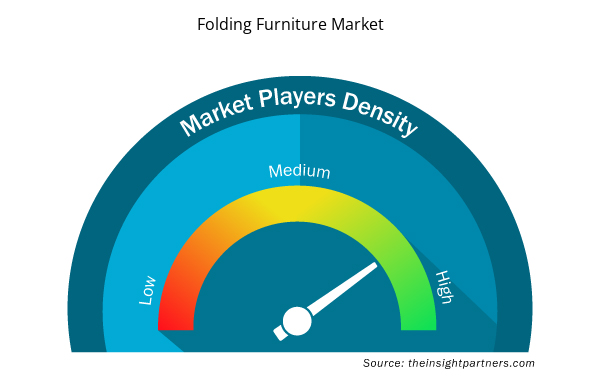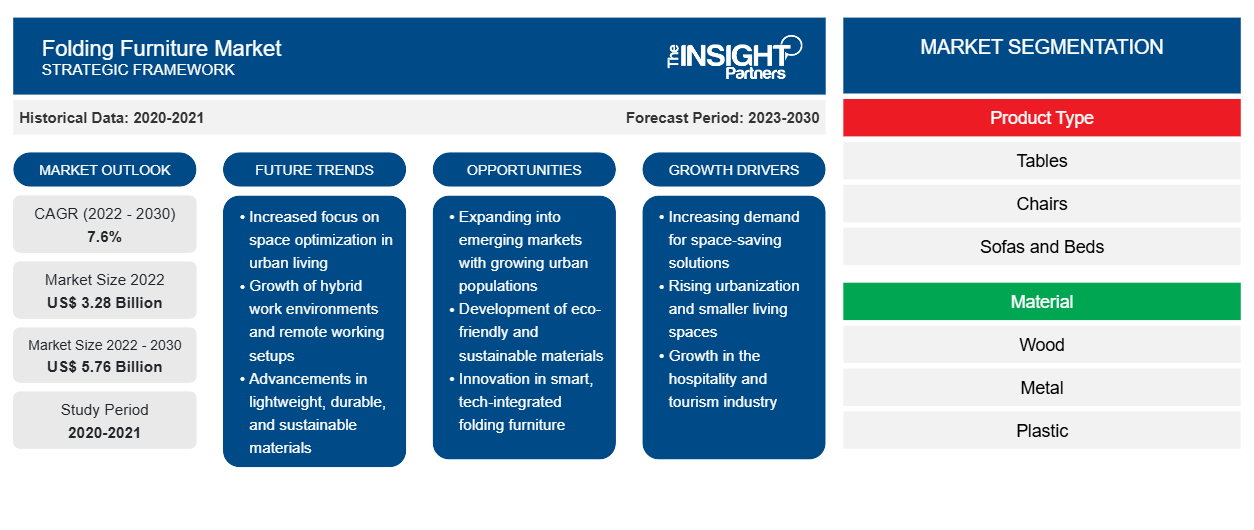[研究报告] 折叠家具市场规模预计将从 2022 年的 32.7605 亿美元增长到 2030 年的 57.6103 亿美元;预计 2023 年至 2030 年市场复合年增长率为 7.6%。
市场洞察和分析师观点:
折叠家具被认为是一种节省空间且便携的家具形式,非常适合家庭结构小型化的人们。这种家具以其多功能性而闻名。这种家具可以轻松变形、折叠或折叠,从而提供更好的空间便携性。快速的城市化步伐、各发达和发展中经济体采用共同生活趋势以及房地产市场的持续增长有利于折叠家具市场的增长。
增长动力和挑战:
折叠家具适合居住在较小空间或单间公寓的人。它是传统家具的适当替代品。折叠家具的多功能性和节省空间的特点增强了可用空间的装饰。折叠家具通常用于商业空间,例如办公室、酒店和医院。由于小型住宅趋势的增加,大多数人口稠密的城市都越来越多地采用这种类型的家具。此外,由于环境问题日益严重,传统木制家具的价格上涨为这些现代产品铺平了道路。这种家具采用塑料和低碳钢等轻质材料制造。因此,塑料和金属折叠家具产品因其成本较低和耐用性更好而越来越受欢迎。此外,单人和双人家庭为占用空间较小的家具铺平了道路。这些因素预计将在预测期内推动折叠家具市场的增长。Lucid Mattress 提供带有重型有线网格支架的折叠金属床架,可有效调整床垫。然而,更换周期较长、原材料价格波动以及制造商之间竞争加剧等因素阻碍了市场增长。
定制此报告以满足您的需求
您可以免费定制任何报告,包括本报告的部分内容、国家级分析、Excel 数据包,以及为初创企业和大学提供优惠和折扣
- 获取此报告的关键市场趋势。这个免费样品将包括数据分析,从市场趋势到估计和预测。
报告细分和范围:
“全球折叠家具市场”根据产品类型、材料、应用、分销渠道和地理位置进行细分。根据产品类型,折叠家具市场分为桌子、椅子、沙发和床。在材料方面,市场分为木材、金属和塑料。按应用,折叠家具市场分为住宅、商业和其他。根据分销渠道,折叠家具市场分为线上和线下。根据地理位置,折叠家具市场分为北美(美国、加拿大和墨西哥)、欧洲(德国、法国、意大利、英国、俄罗斯和欧洲其他地区)、亚太地区(澳大利亚、中国、日本、印度、韩国和亚太地区其他地区)、中东和非洲(南非、沙特阿拉伯、阿联酋和中东和非洲其他地区)以及南美洲和中美洲(巴西、阿根廷和南美洲和中美洲其他地区)
节段分析:
根据应用,折叠家具市场分为住宅、商业和其他。住宅部分占据了相当大的市场份额,预计在预测期内将在折叠家具市场中实现显著的复合年增长率。厨房、餐厅、客厅、卧室和室外区域是需要折叠家具产品的住宅区域。全球住宅建筑活动的增加推动了该细分市场的增长。商业部门的市场预计在预测期内也将大幅增长。折叠家具安装在商业建筑领域的许多子应用中,例如公司办公室、教育机构和医疗中心。它们也安装在自助餐厅和酒店中。
区域分析:
根据地理位置,折叠家具市场分为五个主要区域:北美、欧洲、亚太、南美和中美以及中东和非洲。全球折叠家具市场以亚太地区为主;2022 年该地区的市场价值为 11.5 亿美元。欧洲是该市场的第二大贡献者,占全球市场的近 20%。预计在预测期内,北美折叠家具市场的复合年增长率将达到 8%。在亚太地区,许多人倾向于搬到大城市寻求更好的机会。这种现象逐渐减少了平均居住面积并增加了房屋成本。因此,折叠家具成为这些地区最合适的选择。城市化是推动亚太地区折叠家具市场份额增长的另一个因素。此外,美国、加拿大和墨西哥等美洲国家对单人或双人家庭的偏好日益增加,促使消费者投资此类产品,因为这些产品的使用较少,居住空间较小。此外,英国、德国、英国等发达国家对节省空间的家具的认识不断提高,由于其灵活、易于移动等优势,扩大了欧洲国家折叠家具产品供应商的范围。
行业发展和未来机遇:
以下列出了折叠家具市场主要参与者采取的各种举措:
- 2022 年 4 月,Dorel Industries Inc. 旗下子公司 Dorel Home 重新开放了位于高点市场第 9 层的 C&D 大厦展厅,展示新产品和不断增长的知名授权品牌组合。
- 2022 年 2 月,位于墨西哥瓜达拉哈拉的 Ashley Furniture HomeStore 在墨西哥哈利斯科州瓜达拉哈拉的 Avenida Patria #120 开设了新的 15,000 平方英尺展厅。瓜达拉哈拉店对于扩大 Ashley 品牌在墨西哥的影响力具有重要意义。
- 2019 年 2 月,Inter IKEA Systems BV 推出了带有可折叠桌子的节省空间的搁架单元,可以轻松用作书桌和餐桌。
COVID-19 影响:
COVID-19 疫情影响了各国几乎所有行业。北美、欧洲、亚太地区 (APAC)、南美和中美 (SAM) 以及中东和非洲 (MEA) 的封锁、旅行限制和企业关闭阻碍了多个行业的增长,包括消费品行业。制造部门的关闭扰乱了全球供应链、制造活动、交付时间表以及必需品和非必需品销售。2020 年,各公司的产品交付延迟,产品销量下滑。不同的家具制造商暂时关闭运营或限制生产能力,对折叠家具市场的增长产生负面影响。此外,在危机初期,制造商主要依赖现有库存。由于疫情引发的经济衰退,消费者在购买决策方面变得更加谨慎和挑剔。由于收入较低和收入前景不确定,他们大大限制了非必需品的购买,尤其是在发展中地区。然而,到 2021 年底,许多国家都已全面接种疫苗,各国政府宣布放宽某些规定,包括封锁和旅行禁令。疫情后生活方式的变化,例如越来越强调舒适、便利和个性化,影响了折叠家具的需求。疫情期间在线零售的增长也为折叠家具制造商提供了增长机会。除此之外,贸易限制的放宽也有助于进出口业务,对折叠家具市场的增长产生了积极影响。
折叠家具市场区域洞察
Insight Partners 的分析师已详细解释了预测期内影响折叠家具市场的区域趋势和因素。本节还讨论了北美、欧洲、亚太地区、中东和非洲以及南美和中美洲的折叠家具市场细分和地理位置。

- 获取折叠家具市场的区域特定数据
折叠家具市场报告范围
| 报告属性 | 细节 |
|---|---|
| 2022 年市场规模 | 32.8亿美元 |
| 2030 年市场规模 | 57.6亿美元 |
| 全球复合年增长率(2022 - 2030 年) | 7.6% |
| 史料 | 2020-2021 |
| 预测期 | 2023-2030 |
| 涵盖的领域 | 按产品类型
|
| 覆盖地区和国家 | 北美
|
| 市场领导者和主要公司简介 |
|
市场参与者密度:了解其对商业动态的影响
折叠家具市场正在快速增长,这得益于终端用户需求的不断增长,这些需求源于消费者偏好的不断变化、技术进步以及对产品优势的认识不断提高等因素。随着需求的增加,企业正在扩大其产品范围,进行创新以满足消费者的需求,并利用新兴趋势,从而进一步推动市场增长。
市场参与者密度是指在特定市场或行业内运营的企业或公司的分布情况。它表明在给定市场空间中,相对于其规模或总市场价值,有多少竞争对手(市场参与者)存在。
在折叠家具市场运营的主要公司有:
- 莱格特与普拉特公司
- 阿什利家具工业有限公司
- 宜家控股有限公司
- Hussey 座椅公司
- 索德制造公司
免责声明:上面列出的公司没有按照任何特定顺序排列。

- 了解折叠家具市场的主要参与者概况
竞争格局和重点公司:
全球折叠家具市场的一些知名参与者包括 Leggett & Platt Inc、Ashley Furniture Industries LLC、Inter IKEA Holding BV、Hussey Seating Co、Sauder Manufacturing Co、Meco Corp、Dorel Industries Inc、Maxchief Europe SL、Leisure N Pleasure SARL、Godrej & Boyce Manufacturing Co Ltd。这些市场参与者正在采取战略发展举措进行扩张,进一步推动市场增长。
- 历史分析(2 年)、基准年、预测(7 年)及复合年增长率
- PEST 和 SWOT 分析
- 市场规模价值/数量 - 全球、区域、国家
- 行业和竞争格局
- Excel 数据集



Report Coverage
Revenue forecast, Company Analysis, Industry landscape, Growth factors, and Trends

Segment Covered
This text is related
to segments covered.

Regional Scope
North America, Europe, Asia Pacific, Middle East & Africa, South & Central America

Country Scope
This text is related
to country scope.
常见问题
The increasing advancement in folding furniture is expected to provide lucrative opportunities to the players operating in the folding furniture market.
Rising demand for portable, multi-functional, and space-saving furniture and rapid urbanization along with the growing residential sector are some of the key driving factors for the folding furniture market.
The major players operating in the global folding furniture market are Leggett & Platt Inc, Ashley Furniture Industries LLC, Inter IKEA Holding BV, Hussey Seating Co, Sauder Manufacturing Co, Meco Corp, Dorel Industries Inc, Maxchief Europe SL, Leisure N Pleasure SARL, and Godrej & Boyce Manufacturing Co Ltd among few others.
Based on the product type, the sofas & Beds segment accounted for the largest revenue share as the foldable sofas & beds can be folded inwards and outwards, has extendable legs, and is adjustable for back support, helping reduce back-related complications.
Based on category, online is the fastest-growing segment in the folding furniture market. Online portals such as Amazon, offer various benefits such as home delivery, various secure payment options, attractive discounts, and convenience for customers.
Asia Pacific accounted for the largest share of the global folding furniture market with middle-class population, coupled with growth in urbanization.
Trends and growth analysis reports related to Consumer Goods : READ MORE..
The List of Companies - Folding Furniture Market
- Leggett & Platt Inc
- Ashley Furniture Industries LLC
- Inter IKEA Holding BV
- Hussey Seating Co
- Sauder Manufacturing Co
- Meco Corp
- Dorel Industries Inc
- Maxchief Europe SL
- Leisure N Pleasure SARL
- Godrej & Boyce Manufacturing Co Ltd
The Insight Partners performs research in 4 major stages: Data Collection & Secondary Research, Primary Research, Data Analysis and Data Triangulation & Final Review.
- Data Collection and Secondary Research:
As a market research and consulting firm operating from a decade, we have published and advised several client across the globe. First step for any study will start with an assessment of currently available data and insights from existing reports. Further, historical and current market information is collected from Investor Presentations, Annual Reports, SEC Filings, etc., and other information related to company’s performance and market positioning are gathered from Paid Databases (Factiva, Hoovers, and Reuters) and various other publications available in public domain.
Several associations trade associates, technical forums, institutes, societies and organization are accessed to gain technical as well as market related insights through their publications such as research papers, blogs and press releases related to the studies are referred to get cues about the market. Further, white papers, journals, magazines, and other news articles published in last 3 years are scrutinized and analyzed to understand the current market trends.
- Primary Research:
The primarily interview analysis comprise of data obtained from industry participants interview and answers to survey questions gathered by in-house primary team.
For primary research, interviews are conducted with industry experts/CEOs/Marketing Managers/VPs/Subject Matter Experts from both demand and supply side to get a 360-degree view of the market. The primary team conducts several interviews based on the complexity of the markets to understand the various market trends and dynamics which makes research more credible and precise.
A typical research interview fulfils the following functions:
- Provides first-hand information on the market size, market trends, growth trends, competitive landscape, and outlook
- Validates and strengthens in-house secondary research findings
- Develops the analysis team’s expertise and market understanding
Primary research involves email interactions and telephone interviews for each market, category, segment, and sub-segment across geographies. The participants who typically take part in such a process include, but are not limited to:
- Industry participants: VPs, business development managers, market intelligence managers and national sales managers
- Outside experts: Valuation experts, research analysts and key opinion leaders specializing in the electronics and semiconductor industry.
Below is the breakup of our primary respondents by company, designation, and region:

Once we receive the confirmation from primary research sources or primary respondents, we finalize the base year market estimation and forecast the data as per the macroeconomic and microeconomic factors assessed during data collection.
- Data Analysis:
Once data is validated through both secondary as well as primary respondents, we finalize the market estimations by hypothesis formulation and factor analysis at regional and country level.
- Macro-Economic Factor Analysis:
We analyse macroeconomic indicators such the gross domestic product (GDP), increase in the demand for goods and services across industries, technological advancement, regional economic growth, governmental policies, the influence of COVID-19, PEST analysis, and other aspects. This analysis aids in setting benchmarks for various nations/regions and approximating market splits. Additionally, the general trend of the aforementioned components aid in determining the market's development possibilities.
- Country Level Data:
Various factors that are especially aligned to the country are taken into account to determine the market size for a certain area and country, including the presence of vendors, such as headquarters and offices, the country's GDP, demand patterns, and industry growth. To comprehend the market dynamics for the nation, a number of growth variables, inhibitors, application areas, and current market trends are researched. The aforementioned elements aid in determining the country's overall market's growth potential.
- Company Profile:
The “Table of Contents” is formulated by listing and analyzing more than 25 - 30 companies operating in the market ecosystem across geographies. However, we profile only 10 companies as a standard practice in our syndicate reports. These 10 companies comprise leading, emerging, and regional players. Nonetheless, our analysis is not restricted to the 10 listed companies, we also analyze other companies present in the market to develop a holistic view and understand the prevailing trends. The “Company Profiles” section in the report covers key facts, business description, products & services, financial information, SWOT analysis, and key developments. The financial information presented is extracted from the annual reports and official documents of the publicly listed companies. Upon collecting the information for the sections of respective companies, we verify them via various primary sources and then compile the data in respective company profiles. The company level information helps us in deriving the base number as well as in forecasting the market size.
- Developing Base Number:
Aggregation of sales statistics (2020-2022) and macro-economic factor, and other secondary and primary research insights are utilized to arrive at base number and related market shares for 2022. The data gaps are identified in this step and relevant market data is analyzed, collected from paid primary interviews or databases. On finalizing the base year market size, forecasts are developed on the basis of macro-economic, industry and market growth factors and company level analysis.
- Data Triangulation and Final Review:
The market findings and base year market size calculations are validated from supply as well as demand side. Demand side validations are based on macro-economic factor analysis and benchmarks for respective regions and countries. In case of supply side validations, revenues of major companies are estimated (in case not available) based on industry benchmark, approximate number of employees, product portfolio, and primary interviews revenues are gathered. Further revenue from target product/service segment is assessed to avoid overshooting of market statistics. In case of heavy deviations between supply and demand side values, all thes steps are repeated to achieve synchronization.
We follow an iterative model, wherein we share our research findings with Subject Matter Experts (SME’s) and Key Opinion Leaders (KOLs) until consensus view of the market is not formulated – this model negates any drastic deviation in the opinions of experts. Only validated and universally acceptable research findings are quoted in our reports.
We have important check points that we use to validate our research findings – which we call – data triangulation, where we validate the information, we generate from secondary sources with primary interviews and then we re-validate with our internal data bases and Subject matter experts. This comprehensive model enables us to deliver high quality, reliable data in shortest possible time.


 获取此报告的免费样本
获取此报告的免费样本